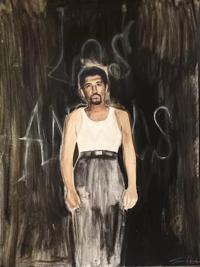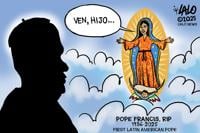“My Cousin Emilio,” oil on canvas, 40″x30″, Salomón Huerta (2023)
COMMENTARY: A journey through Chicana/o art
- Dr. Álvaro Huerta
- Updated
- 0


“Blanca” oil on canvas by Salomón Huerta
For individuals of Mexican origin in el Norte, art has played an important role in our history and culture. In 1932, for example, the great artist David Alfaro Siqueiros (1896–1974) painted a mural, América Tropical, on a wall near Olvera Street in Los Angeles. Not long after depicting American imperialism in the form of an American eagle above the crucifixion of an indigenous body, Siqueiros’ mural was whitewashed by agents of the racist state. Speaking of censorship, another great Mexican artist, Diego Rivera, had his mural, Man at the Crossroads (1933), destroyed at the Rockefeller Center in New York for its criticism of capitalism.
What ever happened to free speech in America?
In the case of art and organizing, during the 1960s and beyond, leaders of the United Farm Workers (UFW) relied on art to organize farmworkers and their supporters. This includes the design of their iconic flag, fliers and posters to promote the historic grape boycott and other organizing efforts (to the present) throughout the United States.


“Untitled,” homegirl portrait, oil on canvas, 7’x4’, Salomón Huerta (1992)
During the early 1970s, the Chicana/o residents of Logan Heights (in San Diego, California) protested the racist government’s actions to build a police station instead of a promised park in their neighborhood. In resistance, they reclaimed the land under the Coronado Bridge and built Chicano Park. As part of their protest, Chicana/o artists helped beautify the park with public murals. The murals include images of indigenous symbols and figures of Mexico, Mexican revolutionaries, Mexican muralists, religious figures (la Virgin de Guadalupe), Chicana/o activists, protest slogans, lowriders and more.
In East Los Angeles, from the early 1970s to the mid-1980s, an important Chicana/o collective of artists, self-described as Asco, emerged. This included Harry Gamboa, Jr., Glugio “Gronk” Nicandro, Patssi Valdez and Willie Herrón III. In his insightful essay, “Your Art Disgusts Me: Early Asco 1972-1975,” UCLA’s Dr. Chon Noriega writes about the significance of Asco against the status quo in mainstream art: “…One evening in 1972, three of its members…signed their names to the entrance of the Los Angeles County Museum of Art (LACMA), claiming the public institution as their own private creation and thus making the world’s largest work of Chicano art in the affluent and white mid-Wilshire area of the city. Spray Paint LACMA (1972), sometimes later referred to as Project Pie in De/Face, was conceived in response to a LACMA curator’s dismissive statement that Chicanos made graffiti not art, hence their absence from the gallery walls. In other words, ‘Chicano art’ was a categorical impossibility…”


“Untitled,” homeboy portrait, oil on canvas, 7’x4’, Salomón Huerta (1992)
For over 50 years, Chicanas/os have been creating art in various mediums at various venues. A great sample of beautiful Chicana/o art can be found in The Cheech Marin Center for Chicano Art & Culture of the Riverside Art Museum. While not all Chicana/o artists have had the opportunity to exhibit at prestigious museums and galleries, the art pioneers of the past have broken the doors open for Brown artists–present and future. The artists of Mexican origin in el Norte must be understood in the context of racial capitalism and anti-Mexicanism—a term best understood by the late and great historian, Dr. Juan Gómez-Quiñones, in his brilliant essay “La Realidad: the Realities of Anti-Mexicanism.”
In short, if we want more Brown kids from America’s barrios to become great artists and exhibit their art–domestically and internationally–they must first see themselves in the best museums and galleries the world has to offer as Salomón Huerta—internationally acclaimed artist—has exemplified with humility and grace for the past 30 years.
Salomón Huerta, M.F.A., is an LA-based artist and his work is featured here. He first gained critical acclaim and commercial attention for his minimalist portraits of the backs of people’s heads and house paintings. He currently exhibits with Harper’s. He was included in the 2000 Whitney Biennial and numerous exhibitions throughout US, Latin America and Europe America, such as The Gagosian Gallery in London, England, and Studio La Città in Verona, Italy. He holds a B.F.A. from Art Center College of Design in Pasadena and an M.F.A. from UCLA.


“Blue Shadow,” oil on canvas, 20″x20″, Salomón Huerta (2023)
In his art series on the homegirls and homegirls (homies), Salomón reflects on his past as a former resident of East Los Angeles’s Ramona Gardens public housing project—better known as the Big Hazard projects for the notorious gang. While some of the subjects are real people, others are not. Salomón doesn’t seek to glorify or romanticize gang members or gang violence. He’s simply reflecting on some of his childhood friends from the projects and other homies.


"Letty,” oil on canvas, 30″x25″, Salomón Huerta (2021)
As a longtime art collector and supporter of the arts, I will say that Salomón’s paintings of the homies represent fine art at its best. While some might argue that I’m biased because he’s my brother, objectively speaking, his academic credentials and refined skills as an artist can’t be denied.
In short, it’s about time that artists of Mexican origin (and Latin American & the Caribbean) in el Norte receive the recognition that they deserve based once and for all.
Tags
Dr. Álvaro Huerta
Get email notifications on {{subject}} daily!
{{description}}
Email notifications are only sent once a day, and only if there are new matching items.
Followed notifications
Please log in to use this feature
Log InMore from this section
Post a comment as anonymous
Report
Watch this discussion. Stop watching this discussion.
Most Popular
-
Opinion | Open letter to the LA Dodgers: Who do you stand with?
-
Billboard Women in Music 2025: Best Latina moments
-
Undocumented immigrants contribute $96.7 billion in taxes; here’s the breakdown
-
Latino man arrested at gunpoint by Border Patrol agents in Pomona
-
Man who spent 30 years in prison is found innocent
-
FIFA seeks volunteers for 2025 Club World Cup
-
Santa Monica will not host beach volleyball during the 2028 Summer Olympics
-
MALDEF joins lawsuit against Huntington Beach
-
Bay Area teacher accused of threatening to deport 10 year old student
-
After $14 million in expenditures, Huntington Park will not build the Aquatic Center at Salt Lake Park
























(0) comments
Welcome to the discussion.
Log In
Keep it Clean. Please avoid obscene, vulgar, lewd, racist or sexually-oriented language.
PLEASE TURN OFF YOUR CAPS LOCK.
Don't Threaten. Threats of harming another person will not be tolerated.
Be Truthful. Don't knowingly lie about anyone or anything.
Be Nice. No racism, sexism or any sort of -ism that is degrading to another person.
Be Proactive. Use the 'Report' link on each comment to let us know of abusive posts.
Share with Us. We'd love to hear eyewitness accounts, the history behind an article.